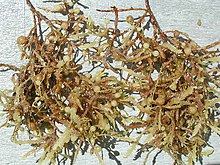
Brown algae are a large group of multicellular algae comprising the class Phaeophyceae. They include many seaweeds located in colder waters of the Northern Hemisphere. Brown algae are the major seaweeds of the temperate and polar regions. Many brown algae, such as members of the order Fucales, commonly grow along rocky seashores. Most brown algae live in marine environments, where they play an important role both as food and as a potential habitat. For instance, Macrocystis, a kelp of the order Laminariales, may reach 60 m (200 ft) in length and forms prominent underwater kelp forests that contain a high level of biodiversity. Another example is Sargassum, which creates unique floating mats of seaweed in the tropical waters of the Sargasso Sea that serve as the habitats for many species. Some members of the class, such as kelps, are used by humans as food.

Sporochnacaeae is the only family in the order Sporochnales in the brown algae. Member of this family are thread-like algae growing by means of an intercalary row of dome shaped cells at the base of the hairs.
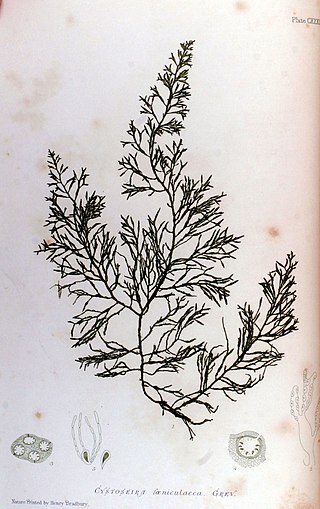
Cystoseira is a genus of brown algae in the order Fucales.

Ectocarpales is a very large order in the brown algae. The order includes families with pseudoparenchymatous (Splachnidiaceae) or true parenchymatous (Scytosiphonaceae) tissue. Pseudoparenchymatous refers to a filamentous alga with cells packed very close together to give an appearance of parenchymatous tissue, the latter being composed of cells which can truly divide in three dimensions, unusual among the algae. Filamentous algae are composed of cells that divide along a single plane, allowing only elongation to form filaments of one or more rows of cells. Algae that can divide in two planes can form sheet-like thalli or bodies. Cells that can divide in a third plane potentially allow for the organism to develop a more complex body plan, and diversification of body plans into an erect thallus of some sort and a holdfast for attaching the upright portion to the substrate.

Turbinaria is a genus of brown algae (Phaeophyceae) found primarily in tropical marine waters. It generally grows on rocky substrates. In tropical Turbinaria species that are often preferentially consumed by herbivorous fishes and echinoids, there is a relatively low level of phenolics and tannins.

Syringodermataceae is a family of brown algae. It includes two genera, Microzonia and Syringoderma.
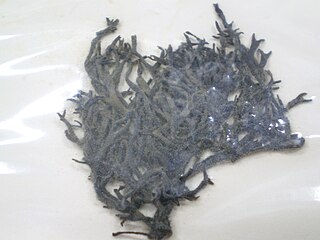
Ishigeales is an order of brown algae. It includes two families, Ishigeaceae and Petrodermataceae. The genus Diplura is also included, but not placed to family.

Tilopteridales is an order of brown algae with isomorphic alternation of generations.
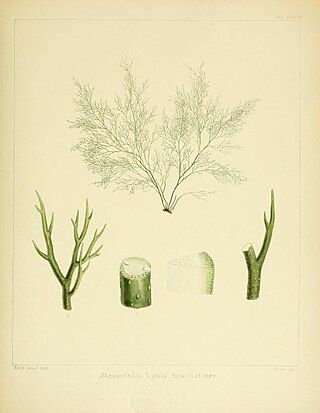
Scytothamnales is an order of brown algae.

Discosporangiales is an order of brown algae. It includes two families, Choristocarpaceae and Discosporangiaceae.
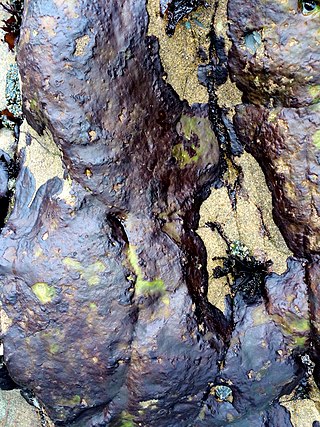
Ralfsiales is an order of crustose brown algae containing two families.
Gongolaria elegans is a species of brown algae in the family Sargassaceae endemic to the Mediterranean.

Splachnidiaceae is a family of brown algae in the order Scytothamnales.

Ralfsiaceae is a family of brown algae in the order Ralfsiales.

Scytosiphonaceae is a family of brown algae in the order Ectocarpales.
Halidrys is a genus of brown algae belonging to the family Sargassaceae.
Sargassopsis is a genus of brown algae belonging to the family Sargassaceae.
Fucophycidae is a subclass of Phaeophyceae which contains the most complex and evolved orders of Chromista algae. The members of this subclass have stalks with several morphological forms and distinct structures, characterized by an intercalary growth and a basic heteromorphic, sometimes secondarily iso- or sub-isomorphic life cycle.
Gongolaria is a genus of brown algae in the family Sargassaceae. It was formerly included in Cystoseira, but was recently found not to be closely related to it.
Stolonophora brandegeei is a species of marine brown algae in the family Sargassaceae, and the only species presenty recognised in the genus Stolonophora.
